Andy Presby
What do the Starship Enterprise’s impulse drives and the Epstein Drives that permitted human colonization of the Solar System in The Expanse have in common? They both rely on nuclear fusion reactors, and we don’t know how to build either of them yet. What we can (and have) built, tested, and in a few cases flown in space are nuclear fission reactors.
Of course, we already have deployed nuclear power systems that rely on the natural decay of a radioactive element to release energy. The U.S. has a long history (particularly NASA) of successful uses of radioisotope thermal generators (RTGs) in many of its famous missions, most recently the Curiosity rover currently operating on Mars.
Experience since the dawn of the Space Age shows that Star Trek was prophecy: budding starship captains (and spacecraft engineers) everywhere want “more power.” Nowhere is this trend more evident than in exploratory spacecraft; compare the electrical power provided by Mars Sojourner rover’s sixteen-watt solar power system1 to the Mars Expedition rovers’ 140 watts.2
The Solar Option
The first question I often hear is “solar power works great in space, so why bother with nuclear reactors?” It is true that the space environment near the Sun is flooded with free power. There is after all a nuclear fusion powered energy source conveniently placed at the center of our Solar System that provides about 1,373 watts per square meter in Earth orbit.
The first problem with solar power is that the farther you get away from the Sun the dimmer the light gets and the larger the solar panel needs to be to generate the same amount of power. The total power level required for a mission may also make solar power unattractive, even closer in to the Sun. Solar panels are relatively light, but this must be balanced against the tremendous size of the structures required to collect large amounts of power. For instance, it takes an array of over three hundred square meters to provide one hundred kilowatts of energy in Earth orbit. Large arrays may be difficult or impossible to fit in current launch vehicles and may cause mass increase on other spacecraft subsystems such as attitude control. Spacecraft engineers have a long history of developing clever low power solutions to design problems but it is still possible that future designers will need higher power levels in Earth orbit for active sensing, communications, or directed energy applications. The Strategic Defense Initiative, for example, generated a number of proposals for communications platforms, sensor systems, and weapons platforms that couldn’t have been reliably solar powered.3
For all these reasons spacecraft designers tend to need a power source besides solar panels if the mission calls for high power sensors like RADAR and LIDAR, high data rate communications, or high power electric propulsion systems; particularly if the mission takes the spacecraft beyond the asteroid belt.
High Power Electric Propulsion
Let’s look at high power electric propulsion a little more closely. Chemical propulsion, which is used almost exclusively now, works by burning fuels in a reaction chamber and exhausting the products out of a nozzle. The fuel acts as both a source of energy and as the reaction mass to achieve rocket thrust through conservation of momentum. Electric propulsion, in contrast, works by using electrical power from the spacecraft’s power system to accelerate a propellant.
The advantage of this technique is that it permits much higher propellant exhaust velocities than chemical propulsion. This can result in using less mass to achieve the same change in spacecraft velocity thereby freeing up more spacecraft mass for payload. The tradeoff is that electrical propulsion systems typically have lower thrust to weight ratios than their chemical cousins. This makes their trip times sensitive to the local gravity field and propulsion selection dependent on where the system will be used.
Electric propulsion performs very well in deep space and is especially useful outside of the sphere of influence of a planet where it runs for long times to build up velocity changes slowly. Electric propulsion can generally get more payload mass to a distant destination faster than chemical propulsion as long as you have a compact power source that can produce the needed power for a long enough period of time.4 That “compact power source” gets harder and harder to get with solar panels the further you get from the Sun as we discussed above.
More Power, Scotty!
There are a number of at alternative ways to get more power on a spacecraft. Neglecting fusion and antimatter reactions (sorry Scotty) in favor of technologies which have been used to provide power outside of a laboratory; there’s solar, chemical, radioisotope decay (as used in most NASA spacecraft that have gone to Jupiter or beyond), and nuclear fission. Of these, nuclear fission power appears to be the technology best able to reliably offer higher power levels for long mission durations.5 The increased power and operational lifetime possible with nuclear fission create new opportunities for those willing to pay the large development costs associated with nuclear fission power sources for space applications. Yes: there’s always a catch. In this case it’s time and money.
Nuclear Fission 101
Nuclear fission is the act of splitting an atom. The amount of energy available in a soda-can sized mass of nuclear fission fuel contains roughly the same amount of energy as fifty fully loaded space shuttle external tanks.
Fission reactions release generally a million times more energy than chemical reactions.
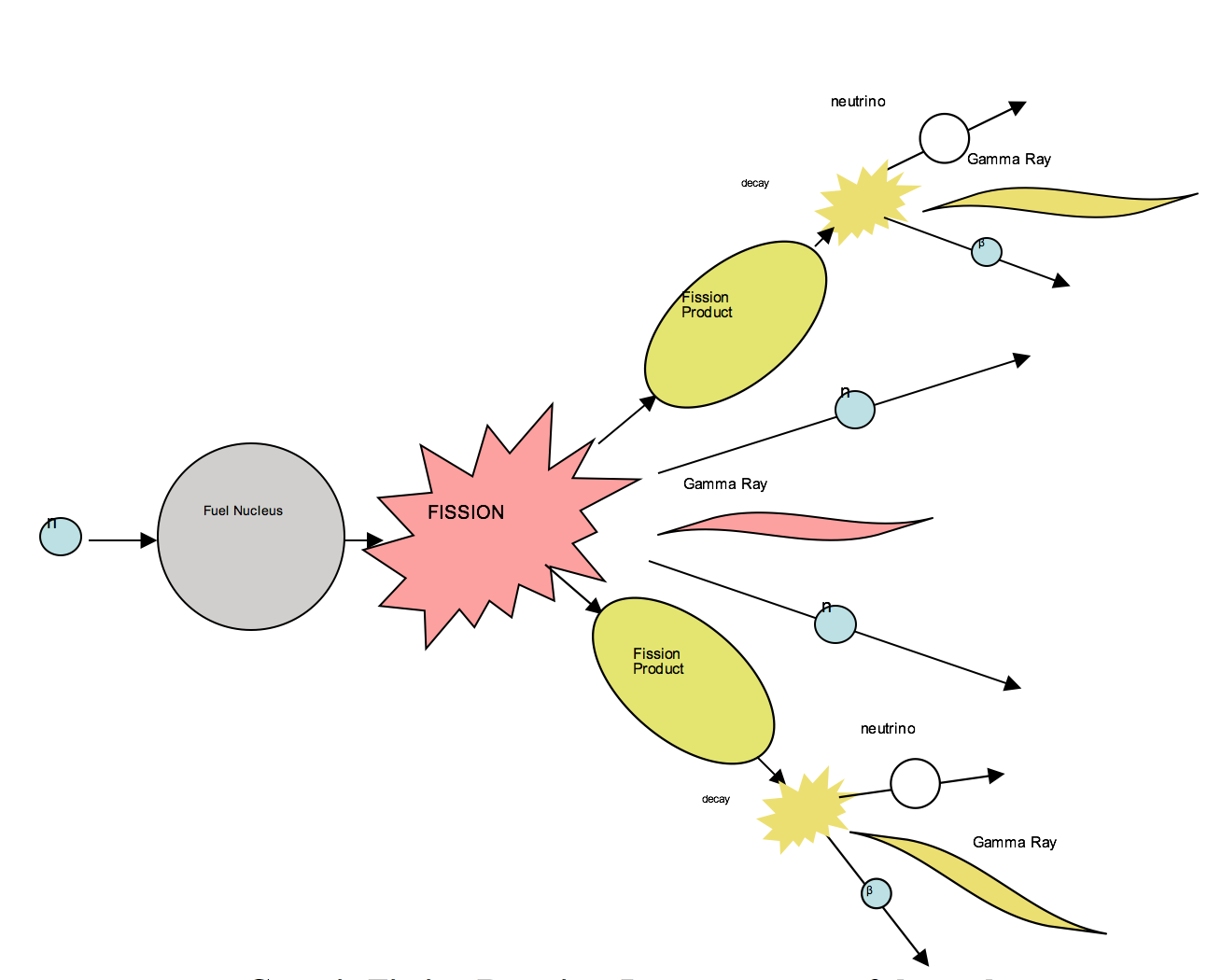
Generic Fission Reaction. Image courtesy of the author.
The figure illustrates several things which are important to a reactor designer. First, note the use of a neutron at the left side of the figure to provide the initial energy to encourage the fuel nucleus to split. The neutrons are necessary to create an unstable compound nucleus which subsequently splits into the various products at the right of the picture. Second, the fission produces a cascade of particles. Each of these particles carries some of the energy liberated a time after the fission event and some of them are radioactively unstable themselves and decay a short time after fission, releasing additional energy. The energy distribution is important in determining how best to extract useful power from a reactor and it is primarily dependent on the choice of nuclear fuel nucleus.
Uranium-235 is the fuel of choice for space reactors because the resulting reactor is relatively easy to control, is relatively stable with a 700,000,000 year half-life (meaning it takes that long for half of a given mass of it to decay), and available in national stockpiles. The primary disadvantage of this fuel is that it is hard to obtain. The most naturally occurring uranium is U-238 isotope. Only about three quarters of one percent of natural occurring uranium is U-235.
Eighty-six percent of the energy liberated appears as the kinetic energy of the two smaller atomic nuclei created by splitting the uranium atom. These are called fission products. These products will only travel a short way inside the reactor and will transfer their energies into random particle motion (aka “heat”) as they slow down inside something. That is to say, most of the energy of the fission products is rapidly turned into heat in the fuel and this is the thermal power that the reactor passes to the rest of the system for conversion to electricity.
The fission products might deposit their energy locally but the other reaction products are not so well-behaved. Neutrinos interact weakly with matter and leave the reactor, representing the first of many energy losses that cannot be used to produce useful work, passing instead out into the environment. Gamma radiation is more interactive than the neutrinos. This is both a blessing and a curse to the designer. The energy of the gamma rays is not necessarily lost and can subsequently be salvaged. However, it is impractical to provide enough dense shielding to stop all of the gammas inside the reactor where they can be converted to heat. Hence, some always leak out of the core, making external radiation shielding a necessity.6
The neutrons released in fission are necessary to sustain and control the reaction. That’s why you hear about “chain reactions” all the time when referring to nuclear fission devices. Every fission event must produce at least one new neutron which goes on to split another atom and continue the reaction. Such a reaction is called “self-sustaining”. The fission of U-235 creates between two and three neutrons on average. The situation is further complicated by the energy of the neutrons produced, the fact that some neutrons always leak out of the reactor, and the necessary presence of materials other than the fuel that absorb neutrons but don’t produce any. These combine to ensure that significant numbers of the neutrons produced do not go on to produce new fission events but are lost from the reactor. This represents another source of lost energy and dangerous radiation that has to be shielded against.
Harnessing fission power means taking care of a number of tasks: capturing the power that comes out of that fission fuel, converting it into useful work, protecting nearby people and equipment from the radiation generated, and keeping the whole contraption from melting itself. It is important to remember that “useful work” could mean a number of things. Most commonly it means electrical power or rocket thrust. A generic space nuclear fission reactor consists of these five basic components diagrammed below.
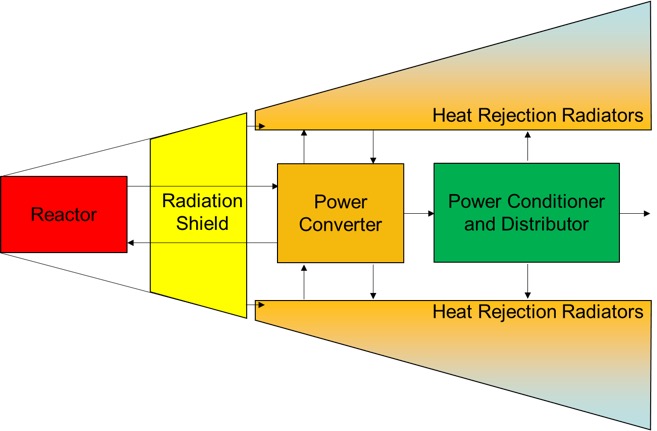
Functional block diagram of a space reactor power system. Image courtesy the author.
The Fission Power Harvest
The reactor generates nuclear fission power by splitting atoms, captures it as heat, and passes it on for subsequent conversion into useful work. Nuclear reactors are classified according to which group of neutrons they rely on to cause fissions: fast or thermal. A fast reactor relies on the fast neutrons that are emitted directly from the fission process itself to go on and cause other fissions.
A thermal reactor contains some material, called a moderator, to slow fast neutrons down to thermal speeds in order to cause fissions. The tradeoff here is that fast reactors require more U-235 molecules in them than thermal reactors but do not require any moderator. The general consensus in the space nuclear power community historically has been that fast reactors are usually smaller and lighter for a given power than thermal reactors.7 This is enough information to conceptually examine a nuclear reactor for space applications.
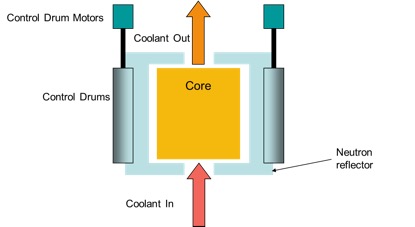
Diagram of a generic space reactor. Image courtesy the author.
The core consists of a quantity of highly enriched uranium-235 packaged in a suitable form known as a fuel element. These elements are fabricated from high temperature structural materials to ensure that the precisely determined shape of the core is maintained during thermal expansion and contraction as the reactor changes temperature. The core is wrapped in a neutron reflector, such as beryllium, which is used to reflect some fraction of the neutrons that escape from the core back in to it so that they are not lost. Movable control drums surround the core serving as selectable neutron absorbers or reflectors. The reflector side acts like the rest of the static neutron reflector: increasing the number of neutrons available for fission in the core. The absorbing side is made of a material which is good at absorbing neutrons, like boron-carbide.
Exposing the core to this side of the control drum allows neutrons to escape until the fission reaction is no longer self-sustaining and the rate of fission drops. The final element in the figure is the coolant that takes the thermal power from the fuel elements and moves it to the electrical conversion equipment. Many different types of coolant are possible; liquid metals have historically been used in U.S. and Russian systems.8
Nuclear fission occurs in the fuel elements and they are consequently the hottest elements of the system. Higher temperatures mean higher efficiencies so the system’s overall performance is largely dependent upon making the hottest fuel elements you can. The complexities of nuclear fuel material engineering are many. Fuel elements are required to contain sufficient inventory of fissile fuel to run the reactor, maintain the proper shape, transfer heat to the coolant, contain dangerous gases that build up during fission, and do so reliably for the design life of the core. This represents a challenging set of material properties.
Many have already been conceived and even gotten through some stage of development, however. The table below gives a listing of fuel materials, the space reactor program that they were associated with, their flight status, and the operating temperature of the fuel in the proposed application.
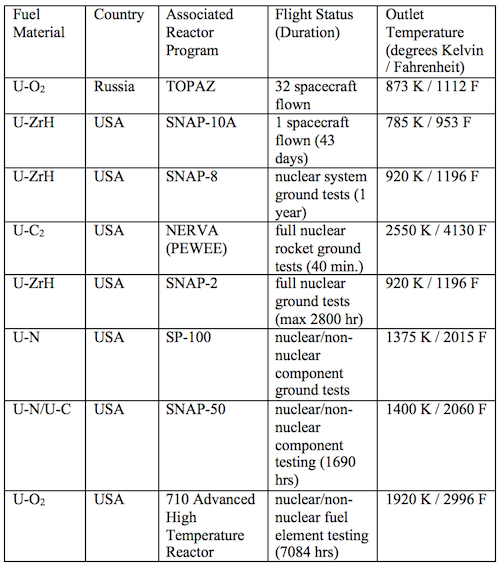
Fuel forms from previous space reactor programs. Table compiled by the author from various sources.9
All the fuels in listed above were designed for used in space-based fission reactors. But what would they have been used for? The short answers are propulsion and power. All of the fuels above were intended to be used in systems to either propel a spacecraft directly or provide electrical power for its use.
Nuclear Thermal Rocketry10
The basic nuclear thermal rocket (NTR) replaces the chemical heat source of a traditional rocket engine burning some chemical fuel with a nuclear reactor as shown below. This device works in all other ways like any other rocket. The action-reaction principle means that you can generate thrust by burning some “fuel” to create a hot gas called “propellant” and direct it out the back using a nozzle. In a traditional chemical rocket, the fuel and propellant are the same stuff and the two words are often used interchangeably. A nuclear thermal rocket changes that a little. The fuel that a nuclear rocket converts into heat is the nuclear fuel in its core. This is different from the propellant, which is kept in a separate tank and is different stuff. That propellant also does double duty to as reactor coolant. So when you run out of propellant, you’ve run out of coolant and must shut down the reactor to avoid melting it. Of course, the exhaust is very hot like chemical rocket exhaust and has the added danger of being potentially radioactive so we would have to be careful how, when, and where we used these. The best thing about NTRs is that the nuclear fission reaction can make much hotter exhaust gas than a chemical rocket. That means much better fuel economy, the need to carry less propellant, and the ability to carry more payload to your destination.
The most straightforward nuclear thermal rocket is for propulsion only and is illustrated below. It does not generate electricity to power the spacecraft’s lights, life support, or phaser banks so the primary power conversion apparatus is the nozzle. There is, hidden in the diagram though, one secondary piece of power conversion equipment; the turbine that uses hot coolant to drive the pump to get the coolant out of its tank. Since there’s no electricity there is no need for electrical power distribution equipment. The expelled propellant cools the reactor too and removes most of the need for radiators.
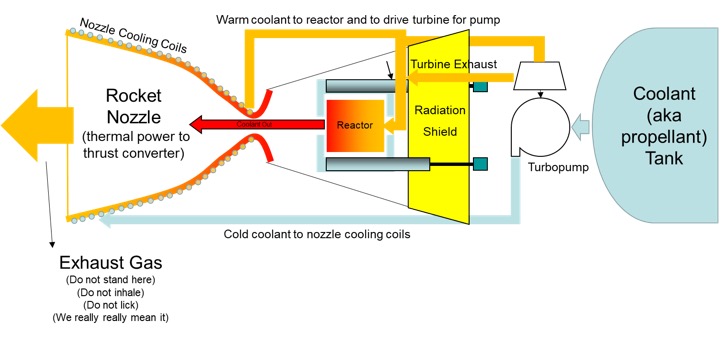
Generic nuclear thermal rocket schematic. Image courtesy of author.
The Nuclear Engine for Rocket Vehicle Applications (NERVA) program of 1955 to 1972 marked the only known United States NTR experiment. These engines were actually built and tested on the ground. None ever flew.
Over twenty-three different reactor designs were tested over the seventeen years of the program. They achieved an impressive variety of feats. The peak temperature they operated at was a little over 4,000 degrees Fahrenheit. A single test engine was restarted twenty-five times to prove its reliability. One NERVA test engine ran continuously for an hour. Compared to the space shuttle’s main engines, thought by many to be the current state of the art in reliable reusable rocket engine technology, the NERVA was nearly twice as efficient in its use of propellant. That meant that a vehicle using a NERVA engine could do the same mission with roughly half the mass of propellant required by a vehicle using the space shuttle’s main engines. While some of that “saved” mass would have had to go to the heavier nuclear engine the bulk of it would be payload.
This means that more people, equipment or cargo could be carried. Unlike other advanced rocket propulsion ideas, like the ion engines flown by NASA on Deep Space One mission, NTRs combine thrust levels comparable to chemical rockets with better fuel mass efficiency. That is why one of the primary reasons these engines were originally conceived to act as the “upper” or final stage for the Apollo missions to the Moon.
Space Nuclear Electric Power Systems
Nuclear reactors on earth are largely used for electrical power generation and similar applications have long been envisioned in space. This involves using a nuclear heat source to drive a dynamic, thermoelectric or thermionic conversion system. The general layout of such a system is shown below.
These systems are “closed cycle” meaning they cannot count on coolant ejection to carry away waste heat like a nuclear thermal rocket. Thus, generating a megawatt of onboard power typically requires at least four megawatts of thermal power from a reactor. This considerable waste heat rapidly comes to drive system mass as desired electrical power level increases.
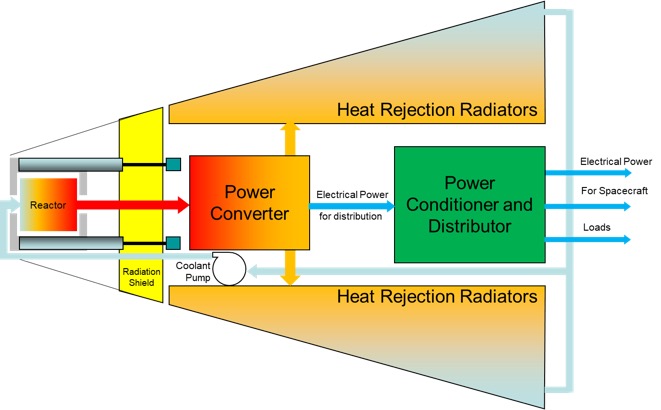
Generic space nuclear electric power system. Image courtesy the author.
One big point to understand about space nuclear reactor power systems is that keeping them cool rapidly becomes the dominant engineering problem that needs to be solved as you start building bigger and bigger plants. What do I mean by that? The key idea is efficiency. The system produces electrical power by converting a fraction of the heat coming off the reactor into electricity. There are physical limits to how big that fraction can be. And it’s not as big as a spacecraft engineer might like it. We might get up to twenty-five percent of the heat of the reactor converted into electricity, but the rest is just plain old heat—the kind that melts things and generally messes up your gear so you must get rid of it. Unlike the nuclear thermal rocket, which dumps the vast majority of its heat out the nozzle, a space nuclear electric power system needs to get rid of heat some other way. The only way to do so in space is to radiate the heat away from the spacecraft with large flat structures that often look a lot like solar arrays. These radiators tend to limit how big you can make a nuclear electric power plant in space. The wonderful thing about nuclear power plants for space is that they scale can up to high power levels very well. In other words, a pretty small reactor can provide a large amount of power for a long time. There’s always a downside though and in this case it’s the radiators mentioned above. As you make the reactor more and more powerful it requires larger and larger (hence heavier and heavier) radiators to keep it cool. This makes advanced radiator technologies a key research area before these systems could be built at higher power levels.
To the best of my knowledge, the only nuclear fission reactors ever flown by any nation have done so to generate electrical power using a method similar to that diagrammed above. The Soviet Union flew thirty-three spacecraft powered by nuclear reactors between 1965 and 1988. These reactors were used to generate electrical power for surveillance satellites with on-board radars.11
The only American space nuclear reactor yet flown was SNAP-10A (launched on 3 April 1965). It was a very low power test reactor which produced around 600 watts of electricity. This reactor used a thermionic power conversion which was only one percent efficient. Though a failed voltage regulator in the spacecraft the SNAP-10 was aboard cut the mission short, the test achieved its objective by demonstrating safe reactor operation in space without undue risk to people or biospheres on Earth.12
The Fission Future
The technologies described above could enable the sorts of human presence in space that generations of science fiction authors (and many other people) have dreamt about. Nuclear thermal rockets can make the twenty-four hour commuter flights to the moon from Arthur C. Clarke’s 2001: A Space Odyssey a routine reality and help start a lunar oxygen mining industry to transport propellant and life support gases to low Earth orbit in meaningful quantities.13 The same rockets can be used to halve the trip time of human missions to Mars: getting astronauts there in three not six months. That means less radiation exposure and less exposure to a weightless environment.14 More advanced designs combine the functionality of a space nuclear power plants and nuclear thermal rockets to produce a “bimodal” system that can provide both high levels of thrust and electrical power for life support, high data rate communications, powerful science sensors, and keeping cryogenic propellants cold. Even more advanced “trimodal” systems add oxygen “afterburners” to get even more impressive thrust for short periods: making the spacecraft more flexible and enabling missions to the asteroids or the moons of Jupiter.15
So at the end of it all, where are we? Well, first I have to be honest: we’re nowhere near the performance of Scotty’s impulse engines or even the Epstein Drives from The Expanse. Unlike those admittedly even more promising fusion technologies, however, the human race has built (and in some cases flown) real hardware based on everything mentioned above. The technology we covered here would be more capable than the propulsion and electric power systems flying on spacecraft today in just about every way. We do not need fundamental breakthroughs in basic physics to know that we can safely control fission reactions and get useful work out of them in machines we operate on a daily basis today in powerplants and naval vessels across the world. We don’t need to invent a reverse-polarized handwavium generator or discover new types of energy to build these things. There’s not even any unobtainium plumbing in anything I’ve mentioned above. There’s just good old-fashioned engineering, a good deal of money, and plenty of will. This gives me for one a great deal of hope for the future of the human adventure in our solar system.
1 NASA Jet Propulsion Laboratory, Mars Microrover Power Subsystem Website. 24 June 1997, 10:00 UTC. Available at: http://mars.jpl.nasa.gov/MPF/roverpwr/power.html. Accessed 2 April 2017.
2 NASA Jet Propulsion Laboratory, Mars Expedition Rover Mission Website. Last update unknown. http://marsrovers.jpl.nasa.gov/mission/spacecraft_rover_energy.html. Accessed 2 April 2017.
3 J. Dearien and J. Whitbeck,”Advanced Multimegawatt Space Nuclear Power Concepts” in Thermal-Hydraulics for Space Power, Propulsion and Thermal Management System Design, W. Krotiuk, ed., Progress in Astronautics and Aeronautics, American Institute of Aeronautics and Astronautics, Inc., Washington, D.C., 1990, Vol. 122, pp. 41-46.
4 R. H. Frisbee, “Advanced Space Propulsion for the 21st Century”, Journal of Propulsion and Power, Vol. 19, No. 6, pp. 1129-1154.
5 J. A. Angelo and D. Buden, Space Nuclear Power, Orbit Book Company, Inc., Malabar, FL, 1985, pg. ix.
6 S. K. Borowksi, “Comparison of Fusion/Antiproton Propulsion Systems for Interplanetary Travel”, NASA-TM-107030/AIAA-87-1814, NASA Lewis Research Center, July 1987, pg 3.
7 M.S. El-Genk, Notes from Space Nuclear Power Systems and Static Energy Conversion Technologies, Short Course on Space Nuclear Power and Propulsion Systems, Albuquerque, N.M., 7-8 February 2004, pp. 47-49.
8 J. A. Angelo and D. Buden, Space Nuclear Power, Orbit Book Company, Inc., Malabar, FL, 1985, pg. 36.
9 This table compiled from the following sources:
J. Dearien and J. Whitbeck,”Advanced Multimegawatt Space Nuclear Power Concepts” in Thermal-Hydraulics for Space Power, Propulsion and Thermal Management System Design, W. Krotiuk, ed., Progress in Astronautics and Aeronautics, American Institute of Aeronautics and Astronautics, Inc., Washington, D.C., 1990, Vol. 122, 41-46;
J. A. Angelo and D. Buden, Space Nuclear Power, Orbit Book Company, Inc., Malabar, FL, 1985;
S. S. Voss, “TOPAZ II System Description”, LA-UR-94-4, Los Alamos National Laboratory, Los Alamos, NM, 1994;
A. Kirpich, G. Kruger, D. Matteo, and J. Stephen, “SP-100 Space Reactor Power System”, in Thermal-Hydraulics for Space Power, Propulsion and Thermal Management System Design, Progress in Astronautics and Aeronautics, W. J. Krotiuk, ed., Vol. 122, pp. 29-39.
10 J. A. Angelo and D. Buden, Space Nuclear Power, Orbit Book Company, Inc., Malabar, FL, 1985, pp. 178-185.
11 Wikipedia contributors. US-A. Wikipedia, The Free Encyclopedia. March 27, 2017, 15:24 UTC. Available at:https://en.wikipedia.org/w/index.php?title=US-A&oldid=772483967. Accessed April 2, 2017.
12 J. A. Angelo and D. Buden, Space Nuclear Power, Orbit Book Company, Inc., Malabar, FL, 1985, pp 167-168.
13 S. K. Borowksi, S. W. Ryan, L. M. Burke, D. R. McCurdy, J. E. Fittje, C. R. Joyner, “Robust Exploration and Commercial Missions to the Moon Using LANTR Propulsion and Lunar Liquid Oxygen Derived from FeO-rich Pyroclastic Deposits”, GRC-E-DAA-TN43359, AIAA Propulsion and Energy Forum 2017; 10-12 Jul. 2017; Atlanta, GA; United States. Access on NASA Technical Reports Server 12 December 2017. Available at: https://ntrs.nasa.gov/search.jsp?R=20170009140&hterms=AIAA-97-2956&qs=N%3D0%26Ntk%3DAll%26Ntx%3Dmode%2Bmatchallany%26Ntt%3DAIAA-97-2956
14 S. K. Borowksi, D. R. McCurdy, T. W. Packard, “Nuclear Thermal Propulsion (NTP): A Proven, Growth Technology for “Fast Transit” Human Missions to Mars”, NASA-TM-2014-218104/AIAA-2013–5354, NASA Glenn Research Center, October 2014, pg 1.
15 S. K. Borowski, M. L. McGuire, L. M. Mason, J. H. Gilland, T. W. Packard, “Bimodal” Nuclear Thermal Rocket (BNTR) Propulsion for an Artificial Gravity HOPE Mission to Callisto”, AIP Conference Proceedings, 654, pp. 829-836.
Copyright © 2017 Andy Presby
Andy Presby is an avid space enthusiast and student of naval history. He consults on future technology for science fiction authors and has degrees in spacecraft systems engineering and astronautical engineering. He was a founding member of BuNine, contributed to House of Steel: the Honorverse Companion, and published fictional nonfiction in the anthology In Fire Forged: Worlds of Honor 5. When not working on that he’s an officer in the U.S. Navy. The views and opinions expressed in this article are his alone and are not those of the United States Navy or any component of the United States government. He’s not authorized to represent Starfleet either but he keeps hoping one day their recruiter will return his phone calls.

